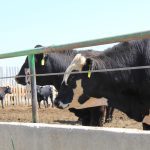
Why post-drought pasture management matters for beef farmers
Knowing how perennial plants function can help producers make better decisions

Structure underpins bull power
Two ranchers explain how they think a herd sire should be put together and why

Manitoba trials address livestock predation in farmyards
Sheep and beef cattle producers tried everything from solar fox lights to predator-resistant penning to reduce predation in the farmyard

Counteracting livestock predation risks on pasture
A three-year study in Manitoba tested several methods of preventing predation of cattle and sheep

Genomic tool identifies hybrid vigour levels in cattle
A made-in-Canada tool reveals breed composition and scores cattle on hybrid vigour

Shifting to the Sandhills calving system to cut scours in young beef calves
While it’s not for every operation, the Sandhills calving system can reduce diarrhea in young calves

Using reproductive tract scoring to pick replacement heifers
A project at the Livestock and Forage Centre of Excellence is comparing conception rates of replacements to earlier reproductive tract scores

Investigating feed efficiency and climate tolerance
Researchers at the University of Alberta are looking into whether there’s a link between feed efficiency and weather tolerance in cattle

Linking the supply chain through modular processing plants
A new company aims to disrupt the meat processing industry and deliver the kinds of cuts customers want through modular buildings

Research into pain management and animal health
North American researchers are studying how pain mitigation affects the health and performance of calves, as well as the economics


